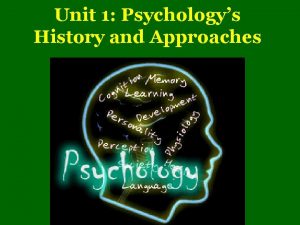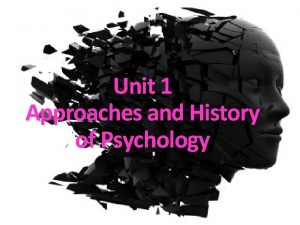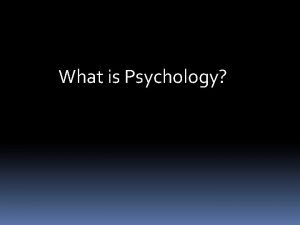APPROACHES TO PSYCHOLOGY There are seven approaches to








- Slides: 8

APPROACHES TO PSYCHOLOGY There are seven approaches to Psychology. They are: 1. Evolutionary 2. Biological 3. Behavioral 4. Cognitive 5. Humanistic 6. Psychodynamic 7. Sociocultural Evolutionary Approach Is the perspective that psychological characteristics of human and non-human animals arose through natural selection. Most recent development, pioneered by David Buss Focus – How the natural selection of traits promotes the perpetuation of one’s genes. Examines behavioural processes in terms of their adaptive value for members of the species over the course of generations. Investigates how primal survival instincts can influence behaviour. Eg. Men are engineered to behave as hunters and women as gatherers. Therefore our visual-spatial organization would be different.

Behavioural Approach • First described by John B. Watson, 1913 • Based on Only observable events (stimulus-response relations) can be studied scientifically. • Emphasized environmental determinants of behavior – Role of heredity greatly deemphasized but not totally denied – Environment can be manipulated to change behavior, whereas heredity cannot • Deal with directly observable behaviors – Explain behavior by assessing the effects of external stimuli – Behavior is determined by the occurrence of external events • Behavior is the result of learned associations between stimuli and responses to them • The main theories are of classical (Pavlov) and operant (Skinner) conditioning

• The Psychodynamic Approach • Fathered by Sigmund Freud. • Our behavior comes from unconscious drives. Usually stemming from our childhood. • Emphasizes internal, unconscious conflicts; the focus is on sexual and aggressive instincts that collide with cultural norms. Key features (1): • Mind has 3 parts: conscious, unconscious and preconscious – conscious: thoughts and perceptions. – preconscious: available to consciousness, e. g. memories and stored knowledge. – unconscious: wishes and desires formed in childhood, biological urges. Determines most of behaviour. • Personality has 3 components - id, ego & superego – id: unconscious, urges needing instant gratification. – ego: develops in childhood, rational. Chooses between id and external demands. – superego: conscience, places restrictions on behaviour.

Key features (3): Psychosexual stages of development • Develop through stages in childhood – Oral (0– 18 months) – Anal (18 months– 3 years) – Phallic (3– 6 years) – Latent (6 yrs–puberty) – Genital (puberty onwards) • At each stage, libido is focused on different part of body. • Failure to progress (fixating) causes neuroses.

The Cognitive Approach • Developed by Wolfgang Kohler in the early 1900 s. Others include Kurt Koffka and Max Wertheimer. • Origins can be traced to Gestalt psychology, as cognitive psychologists study thoughts and mental processes. • Concerned with intelligent action: thinking, perceiving, planning, imagining, creating, dreaming, speaking, listening, and problem solving. • Based on: Human behavior cannot be fully understood without examining how people acquire, store, and process information. • Significant contributions made in the areas of language, thought, and memory. • Prominent figures include Jerome Bruner who proposed Discovery Learning. David Ausubel proposed Reception Learning while Jean Piaget proposed Cognitive Developmental Theory of Learning.

Biological Approach • Focuses primarily on the activities of the nervous system, the brain, hormones, and genetics. • Behavior understood by describing underlying biochemical and neurological causes. • Based on: An organism’s functioning can be explained in terms of the bodily structures and bio- chemical processes that underlie behaviour. • Reductionist: Observable behaviours reduced to physiological explanations. • Other Principal Contributors: James Olds, David Hubel, Torsten Wiesel.

Humanistic Approach • Emerged in the 1950 s. • Based on: Humans are free, rational beings with the potential for personal growth, and they are fundamentally different from animals. • opposed the determinism of behaviorism and psychoanalysis (believed too much emphasis placed on “rat studies” in the understanding of human behavior. • Emphasized the inherent goodness of human beings. • Developed methods of psychotherapy consistent with their views. • Prominent figures include Carl Rogers, Abraham Maslow, and Gordon Allport.

Socio-cultural Approach • Is based on the assumption that our personalities, beliefs, attitudes, and skills are learned from others. • It is possible to fully understand a person without understanding his or her culture, ethnic identity, gender identity, and other important sociocultural factors. • How behavior and thinking vary across situations and cultures.














